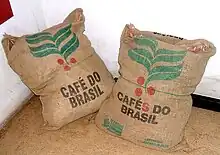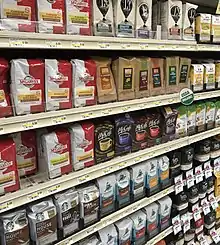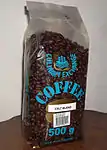
A coffee bag is a container for shipping and storing coffee. Coffee beans are usually transported in large jute sacks, while coffee sold to consumers may be packaged as beans or ground coffee in a small, sealed plastic bag.[1]
Bulk coffee
Large bulk bags, burlap bags or gunny sacks are traditionally used for storage and transport of coffee beans. Often, it is made of jute and has a content of 60 kilograms (130 pounds); this type of bag originated in Brazil and became a worldwide standard.[2] It also became a measurement unit to this day, for example FAO's statistics on coffee production are expressed in 60-kg bags.[3]
Jute fibers are treated with mineral oil, or historically whale oil, to improve spinnability, which raised questions about coffee contamination from these hydrocarbons, but further studies showed it to be infinitesimal.[4] Bags with synthetic fibers (woven or non-woven) are commonly used now.
Once used, these decorative bags can be recycled or upcycled for many uses, including in clothing.[5]
The 60 kg sack is starting to be replaced by huge polypropylene or polyethylene bags, such as the flexible intermediate bulk container. These are increasingly used for coffee exports - especially from Brazil.[6] Intermodal shipping containers are common for international shipping.
Consumer packaging

Smaller bags are used by consumers for coffee beans or ground coffee. Multi-layer graphics bags have largely replaced steel cans (tins) for consumer ground coffee. There is a tendency for pressure from carbon dioxide to build up in these barrier bags. Special pressure relief valves have been developed to relieve the pressure without letting the atmosphere into the bags.[7][8][9] Valves are either heat sealed or attached by adhesive. The bags are not readily recyclable but compare favourably in life-cycle studies with metal cans on broader issues.[10]
Examples
 Multilayer plastic bag with a pressure-relief valve
Multilayer plastic bag with a pressure-relief valve Coffee beans in a plastic bag purchased at local grocery store
Coffee beans in a plastic bag purchased at local grocery store Coffee grinder at grocery store with a paper bag for ground coffee
Coffee grinder at grocery store with a paper bag for ground coffee
References
- Yam, K.L., "Encyclopedia of Packaging Technology", John Wiley & Sons, 2009, ISBN 978-0-470-08704-6
- ↑ Hoffmann, James (2014). The World Atlas of Coffee: From Beans to Brewing -- Coffees Explored, Explained and Enjoyed. Richmond Hill, Ontario. ISBN 978-1770854703.
{{cite book}}: CS1 maint: location missing publisher (link) - ↑ Marcelo Raffaelli (15 January 1995). Woodhead Publishing (ed.). Rise and Demise of Commodity Agreements : An Investigation into the Breakdown of International Commodity Agreements. Woodhead. p. 256. ISBN 978-1855731790.
- ↑ "Annex 1: World Coffe Production Statistics". Retrieved 2016-12-25.
- ↑ Mustafizur Rahman (2000). "The Contamination of Jute Products". The Journal of the Textile Institute. 92 (2): 146–149.
- ↑ "Cappuccino vs. Latte vs. Macchiato vs. Mocha vs. Flat White". Retrieved 2017-06-24.
- ↑ Reese Ewing (20 December 2015). "Brazil ditches standard jute coffee bags, leading move toward bulk". Reuters. Retrieved 2016-12-25.
- ↑ Cowell, J. A. (2018). One-way Degassing Valve Behavior & Function in The Acceptability of Stored Coffee (PDF) (MSc). The University of Guelph. Retrieved November 2, 2019.
- ↑ US4000846A, Seymour Gilbert, "Pressure relief valve and bag incorporating same", published 1977
- ↑ US 6,663,284B2, Buckingham, "PRESSURE SENSITIVE ONE-WAY VALVE", published 2003
- ↑ Demetrakakes, P (2017). "The Future of K-Cups and Other Coffee Packaging". Retrieved 9 December 2019.
{{cite journal}}: Cite journal requires|journal=(help)